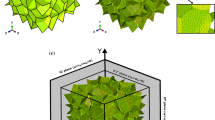Abstract
Based on the elongated Kelvin model, the effect of microstructure on the uniaxial strength asymmetry of open-cell foams is investigated. The results indicate that this asymmetry depends on the relative density, the solid material, the cell morphology, and the strut geometry of open-cell foams. Even though the solid material has the same tensile and compressive strength, the tensile and compressive strength of open-cell foams with asymmetrical sectional struts are still different. In addition, with the increasing degree of anisotropy, the uniaxial strength as well as the strength asymmetry increases in the rise direction but reduces in the transverse direction. Moreover, the plastic collapse ratio between two directions is verified to depend mainly on the cell morphology. The predicted results are compared with Gibson and Ashby’s theoretical results as well as the experimental data reported in the literature, which validates that the elongated Kelvin model is accurate in explaining the strength asymmetry presented in realistic open-cell foams.
Similar content being viewed by others
References
Gibson, L. J. and Ashby, M. F. Cellular Solids: Structure & Properties, Pergamon Press, Oxford (1997)
Gibson, L. J., Ashby, M. F., Zhang, J., and Triantafillou, T. C. Failure surfaces for cellular materials under multiaxial loads I: modeling. International Journal of Mechanical Sciences, 31(9), 635–663 (1989)
Gioux, G., McCormack, T. M., and Gibson, L. J. Failure of aluminum foams under multiaxial loads. International Journal of Mechanical Sciences, 42(6), 1097–1117 (2000)
Kim, H. S. and Al-Hassani, S. T. S. The effect of doubly tapered strut morphology on the plasticyield surface of cellular materials. International Journal of Mechanical Sciences, 44(8), 1559–1581 (2002)
Amsterdam, E., Hosson, J. D., and Onck, P. R. On the plastic collapse stress of open-cell aluminum foam. Scripta Materialia, 59(6), 653–656 (2008)
Marchi, C. S. and Mortensen, A. Deformation of open-cell aluminum foam. Acta Materialia, 49(19), 3959–3969 (2001)
Despois, F. J., Mueller, R., and Mortensen, A. Uniaxial deformation of microcellular metals. Acta Materialia, 54(16), 4129–4142 (2006)
Ford, C. M. and Gibson, L. J. Uniaxial strength asymmetry in cellular materials: an analytical model. International Journal of Mechanical Sciences, 40(6), 521–531 (1998)
Xie, L. S. and Chan, K. C. The effect of strut geometry on the yielding behaviour of open-cell foams. International Journal of Mechanical Sciences, 48(3), 249–255 (2006)
Perrot, C., Panneton, R., and Olny, X. Periodic unit cell reconstruction of porous media: application to open-cell aluminum foams. Journal of Applied Physics, 101(11), 113538 (2007) DOI 10.1063/1.2745095
Jang, W. Y., Kraynik, A. M., and Kyriakides, S. On the microstructure of open-cell foams and its effect on elastic properties. International Journal of Solids and Structures, 45(7), 1845–1875 (2008)
Gong, L., Kyriakides, S., and Jang, W. Y. Compressive response of open-cell foams, part I: morphology and elastic properties. International Journal of Solids and Structures, 42(5), 1355–1379 (2005)
Xie, L. S., Tong, G. Q., and Gao, L. Elastic properties of the Kelvin foams with open-cells. Chinese Journal of Applied Mechanics, 24(1), 75–79 (2007)
Thiyagasundaram, P., Sankar, B. V., and Arakere, N. K. Elastic properties of open-cell foams with tetrakaidecahedral cells using finite element analysis. AIAA Journal, 48(4), 818–828 (2010)
Jang, W. Y., Kyriakides, S., and Kraynik, A. M. On the compressive strength of open-cell metal foams with Kelvin and random cell structures. International Journal of Solids and Structures, 47(21), 2872–2883 (2010)
Li, Z. Q., Xi, C. Q., Jing, L., Wang, Z. H., and Zhao, L. M. Effect of loading rate on the compressive properties of open-cell metal foams. Materials Science and Engineering A, 592(13), 221–229 (2014)
Xu, W. G., Zhang, H. T., Wei, W., Yang, Z. M., and Zhang, J. S. Numerical and experimental investigations on the electrical conductivity of foam materials. Special Topics & Reviews in Porous Media: An International Journal, 2(1), 35–42 (2011)
Yang, X. H., Kuang, J. J., Lu, T. J., Han, F. S., and Kim, T. A simplistic analytical unit cell based model for the effective thermal conductivity of high porosity open-cell metal foams. Journal of Physics D: Applied Physics, 46(25), 255302 (2013)
Lu, Z. X., Zhang, C. G., Liu, Q., and Yang, Z. Y. Surface effects on the mechanical properties of nanoporous materials. Journal of Physics D: Applied Physics, 44(39), 395–404 (2011) DOI 10.1088/0022-3727/44/39/395404
Lu, Z. X., Liu, Q., and Huang, J. X. Analysis of defects on the compressive behaviors of open-cell metal foams through models using the FEM. Materials Science and Engineering A, 530, 285–296 (2011)
Lu, Z. X., Huang, J. X., and Chen, X. Analysis and simulation of high strain compression of anisotropic open-cell elastic foams. Science China Technological Sciences, 53(3), 863–869 (2010)
Lu, Z. X., Liu, Q., and Chen, X. Analysis and simulation for the tensile behavior of anisotropic open-cell elastic foams. Applied Mathematics and Mechanics (English Edition), 35 (11), 1437–1446 (2014) DOI 10.1007/s10483-014-1874-7
Sullivan, R. M., Ghoson, L. J., and Lerch, B. A. A general tetrakaidecahedron model for opencelled foams. International Journal of Solids and Structures, 45(6), 1754–1765 (2008)
Zhu, H. X., Knott, J. F., and Mills, N. J. Analysis of the elastic properties of open-cell foams with tetrakaidecahedral cells. Journal of the Mechanics and Physics of Solids, 45(3), 319–343 (1997)
Author information
Authors and Affiliations
Corresponding author
Additional information
Project supported by the National Natural Science Foundation of China (Nos. 11472025 and 11272030)
Rights and permissions
About this article
Cite this article
Lu, Zx., Huang, Jx. & Yuan, Zs. Effects of microstructure on uniaxial strength asymmetry of open-cell foams. Appl. Math. Mech.-Engl. Ed. 36, 37–46 (2015). https://doi.org/10.1007/s10483-015-1893-9
Received:
Revised:
Published:
Issue Date:
DOI: https://doi.org/10.1007/s10483-015-1893-9




